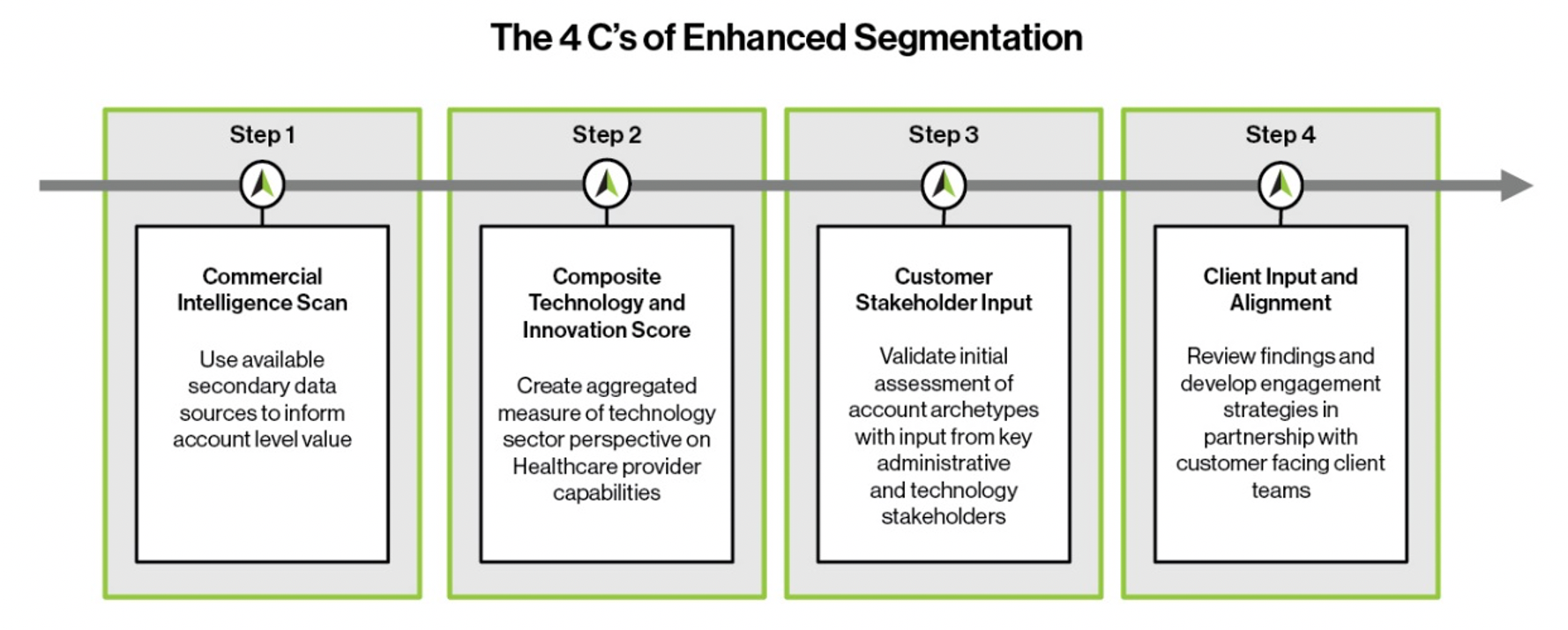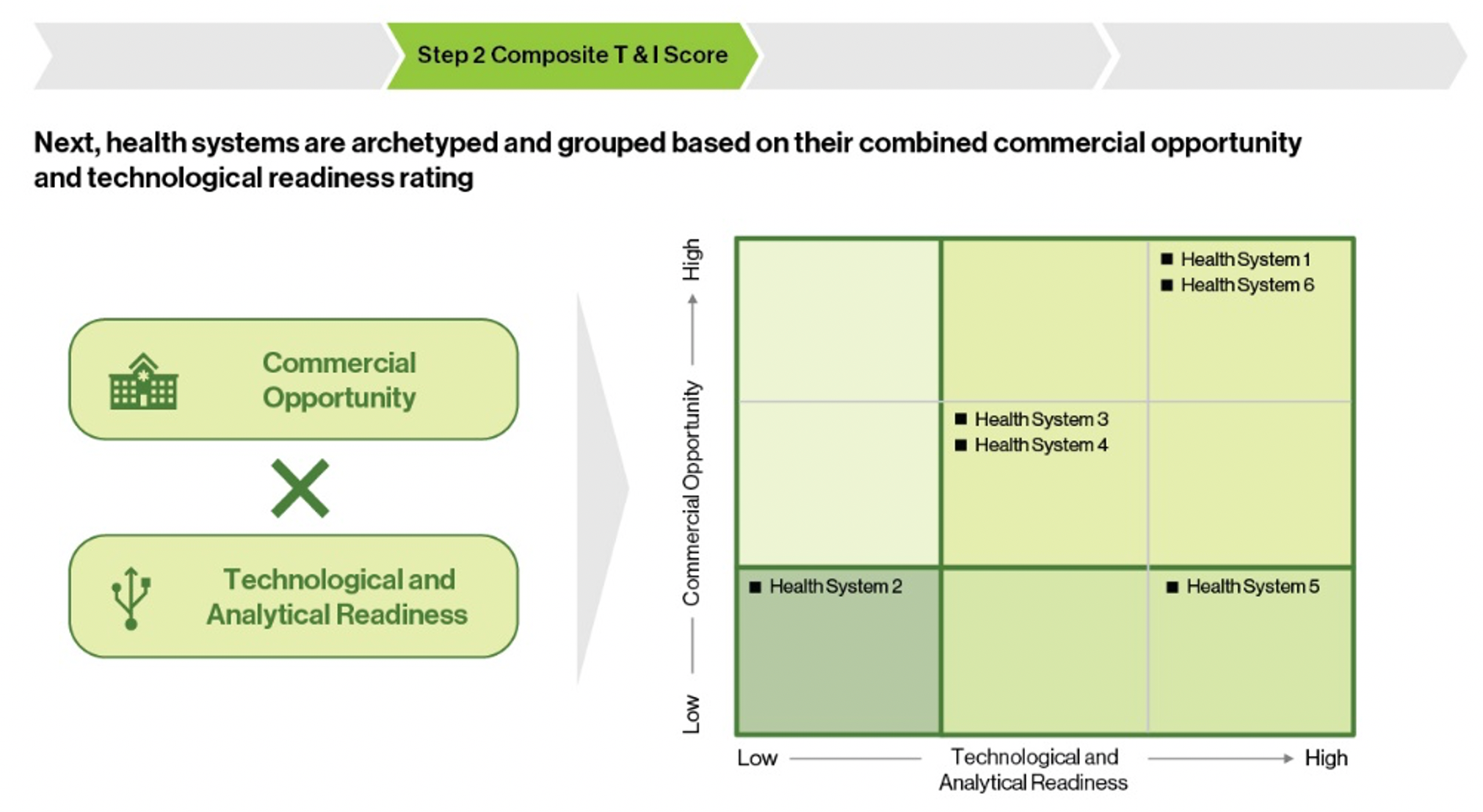Bringing Data to Life: How Tech-Savvy Life Sciences Companies Can Better Serve the Healthcare Sector
Going beyond traditional market segmentation to understand the technological and data analytics capacity of target customers.
When the U.S. mandate for the meaningful use of electronic health records (EHR) went into effect as part of the Health Information Technology for Economic and Clinical Health Act in 2009, hospitals and health systems across the country began evolving their processes and technology to comply. Nowadays, significant differences exist in technology sophistication and integration across these organizations. This fact coupled with the increased availability of data and ever-better computing power offers pharmaceutical companies an important opportunity to more effectively serve these important customers.
By going beyond traditional market segmentation to understand the technological and data analytics capacity of these target customers, pharma companies can fine-tune go-to-market decisions and create stronger, more tailored strategies and programs. This article demonstrates how an innovative segmentation model can enable tech-savvy life sciences companies to better serve their healthcare customers.
The limits of ‘meaningful use’
Used as a standard methodology to group accounts based on common characteristics, traditional market segmentation helps business leaders develop go-to-market strategies based on demographic, geographic, behavioral, and psychographic considerations. These factors can help characterize an account’s commercial opportunity, incorporating indicators such as capacity and patient volume, patient mix, employees, organization type, services, and financials.
However, as technology plays an increasingly important role in the diagnoses of diseases and treatment, traditional segmentation fails to factor in the role technology plays within a hospital or health system, and a specific organization’s ability – or inability – to collect, track, integrate, monitor, and/or analyze data.
For contextual reference, the concept of meaningful use focused on prioritizing health outcomes by improving quality, safety, efficiency and access to healthcare. Policies were created and enforced in stages over time to improve care coordination as well as population and public health. Accordingly, hospitals and health systems began implementing new processes, procedures, and technologies requiring substantial investment in data infrastructure and storage.
As a result, some health system sites are well-integrated strategically, operationally, and technologically. However, many systems were developed over time largely to meet the minimum requirements, and feature varying degrees of integration and sophistication. This means on the lower end of the spectrum, some health systems are using technology in a limited capacity, for example, to securely store medical records and to manage revenue cycle activities.
However, on the high-performance end of the spectrum, hospitals and health systems are able to leverage data on clinical and economic outcomes across patient and provider characteristics, conditions, and therapies to inform improvements in care quality, and/or cost. Recognizing the ability of health systems to leverage data is a critical first step for manufacturers to take to engage these health systems in deeper and more meaningful ways.
This will enable pharmaceutical companies to engage more effectively for three main reasons.
3 key benefits of tech segmentation and engagement
First, if you’re leading a pharmaceutical company that is research-and-development-driven, you want to be perceived as a partner in delivering optimal health outcomes. Otherwise, you will be competing primarily based on pricing and contracting, essentially limiting your relationship to that of a commodity supplier. Keeping in mind, no payer or provider wants to unnecessarily give a new, expensive drug to a patient without having a clear understanding of its potential positive outcome.
A health system that has robust data analytics capabilities will be better suited to target points of high impact for new treatment options. This includes identifying appropriate providers and potential patients who could benefit most, as well as tracking the outcomes of the novel treatment. As a result, you will be more assured of reaching early-adopter providers who have the right patients, as well as gaining access to those outcomes, which also help you demonstrate the overall clinical and economic value of the novel product. The more you know early on, the better able you will be to develop the market for increased adoption.
Second, a pharmaceutical company’s knowledge of a health system’s data capabilities allows for a tailored approach to customer engagement and solution development.
For example, a leading global pharmaceutical company with a novel treatment for a rare cardio-vascular condition developed an application to review medical records in search of high-risk patients. Understanding the variability in technology sophistication across health systems enabled the company to develop a variety of adaptable approaches to implementation.
Health systems with sophisticated EHR capabilities could simply build a similar application themselves based on a set of instructions. For health systems without this capability, the global company could, for example, leverage a more “turnkey solution” for health systems to download and install the application on their existing platform.
Third, leveraging data to drive health outcomes benefits all involved. Clinicians get guidance on diagnosis and treatment, patients receive treatment options that are more targeted to their individual needs, and providers and payers can more defensibly measure clinical and economic value. Meanwhile, pharmaceutical companies gain opportunities to gather evidence related to how their interventions deliver on real-world health outcomes, e.g., medical cost offsets, hospitalizations, 30-day readmissions, etc.
The ability to generate and capture these advanced data, however, greatly varies across the spectrum of health systems, underscoring the importance of taking an innovative and sophisticated approach to segmentation.
The 4 C’s of enhanced segmentation
The innovative segmentation strategy uses a four-step process to ascertain health system technological and analytical readiness, as follows.
Click to enlarge

Step 1: The Commercial Intelligence Scan
This relatively traditional step employs the aggregation of a variety of sources – claims data, market intelligence data, financials, medical literature, syndicated market research, etc. – to build a database to visualize the market and its segments at the account level. The collected data is integrated into a usable metric that tells the story of an account’s commercial opportunity, incorporating key indicators, as mentioned above.
Step 2: Composite Technology and Innovation Score
This novel step provides a holistic view of health systems by assessing and segmenting technological sophistication. By using sources such as tech industry surveys, rating systems and frameworks, and CMS “meaningful use” criteria, three key metrics of tech readiness can be investigated and analyzed:
- Capability – The variety of abilities, functions, and platforms utilized by the provider account.
- Effectiveness – The ability of the provider account to create tangible and measurable improvements within the health system using technology.
- Adoption – The extent to which technology and analytics tools are consistently deployed and utilized throughout the health system or healthcare provider network.
From there, a composite technological readiness score can be calculated at the health system level.Provider accounts can then be assessed based on commercial opportunity and technological readiness, and archetyped based on similar characteristics across these two dimensions.
Click to enlarge

For example, before conducting technology and analytics segmentation, a leading pharma company’s team planned to target 80 health system accounts. The enhanced segmentation methodology narrowed the group to 20 “technology champions” that could theoretically deploy an analytics solution immediately, and bucketed the other accounts into three additional archetypes for uniquely tailored strategies.
In other words, the results of the enhanced segmentation helped the company more effectively understand, prioritize, and target the 80 accounts. Had the company leadership team skipped the enhanced segmentation process, they likely could have misaligned their go-to-market strategies, under-reached with some potential customers, over-reached with others, and ultimately lost opportunities.
Step 3: Customer Stakeholder Input
While the composite score for technology and innovation informs technological differences among accounts, multidisciplinary stakeholder input is necessary to verify the placement of accounts within the segmentation framework. Because secondary resources and segmentation only provide an overarching view of accounts, primary research is used to uncover additional granularity and insights. So, where Step 2’s technology and innovation composite score inform technological differences among accounts, Step 3 gets input from multidisciplinary stakeholders to verify the placement of accounts, using one or both of the following research approaches:
- One-on-one interviews, supporting account-level insight generation and confirmation of segmentation assignments.
- Survey research, enabling the extrapolation of segmentation findings to the broader customer universe.
For example, in one recent case, interviews with technology stakeholders across different sites within a health system uncovered site-level nuances that demonstrated differing levels of technical readiness across the account. More specifically, gaps in technical capability between different sites could indicate inability to execute and implement a technical solution system-wide. Conversely, shortcomings in technical capability could signal a need and a desire for external partnership to bridge gaps between sites and implement a solution system-wide. These account-level discussions helped the pharma company’s team gain a fuller understanding of the entire system’s capabilities, needs, and interests, inclusive of inter-site discrepancies, which informed a more nuanced and tailored approach to solution development.
Step 4: Client Input and Alignment
This customary best-practice step seeks to align key internal pharma stakeholders to research findings and strategic recommendations, starting with alignment on segmentation methodology and sample. As these are the account managers and field teams who work most closely with health system customers, it is critical to share findings with them to solicit their feedback and gain perspectives and buy in. This can be done through a myriad of approaches, including workshops, one-on-one meetings, or surveys.
While this may or may not change where a prospective health system customer is mapped on the matrix, it more likely will provide insights to inform strategy, and, importantly, facilitate internal alignment and execution.
From there, the company’s team can begin defining and developing next steps for account-specific strategic engagement, including:
- Crafting detailed engagement strategies per archetype
- Prioritizing and targeting key accounts based on archetyping analysis
- Integrating analysis and findings with parallel workstreams
- Building an account team playbook for targeted execution of the engagement strategies
Without a clear understanding of a hospital’s or health system’s technology, you cannot tailor your go-to-market plans and strategies as purposefully – and significant opportunities to advance health outcomes could be missed.
As access to data continues to increase and technology continues to advance, those tech-savvy pharmaceutical leaders who institutionalize enhanced account segmentation will be best positioned as partners in the improvement of quality, safety, and efficiency of patient care.
Brian Sattin is a director in the Life Sciences practice at Guidehouse, Zachary Kleiman is a consultant in the Life Sciences practice at Guidehouse
Is Artificial Intelligence a ‘Product’? Products Liability Implications for AI-Based Products
April 10th 2025As the physical products we use evolve to become increasingly complex, traditional products liability frameworks may not always fit to provide remedies for harm that can result from using novel product types.